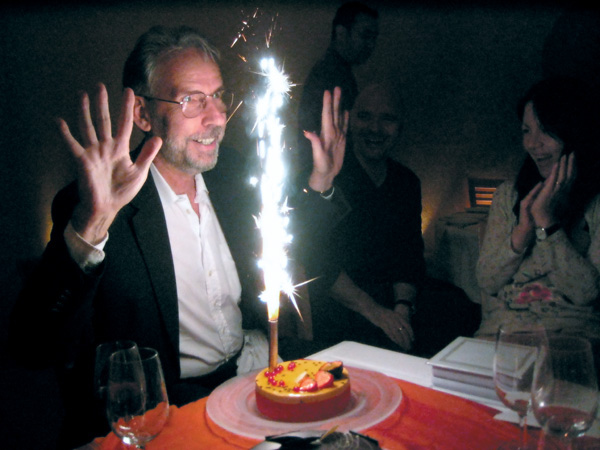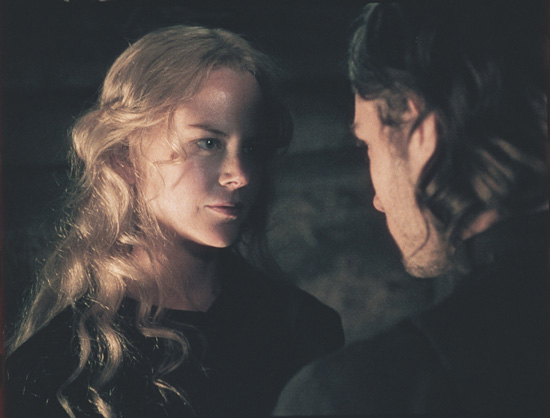Chapter 9. Another Rubicon Crossed
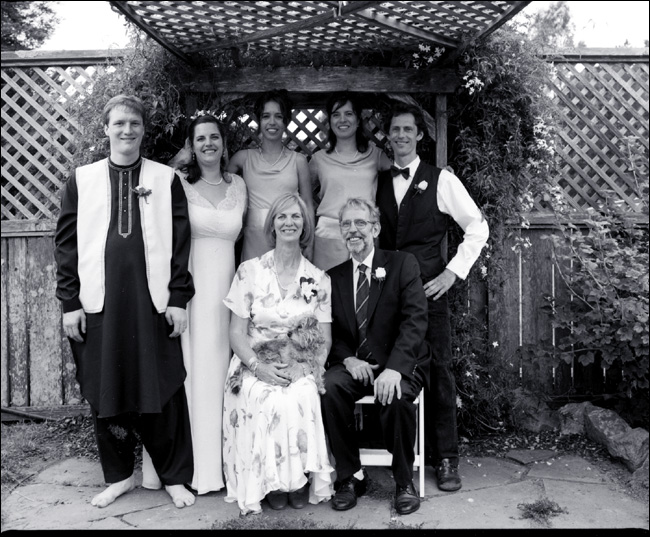
The Murch family at Beatrice’s wedding.
JUNE 7, 2003—BLACKBERRY FARM, CALIFORNIA
On a warm, overcast afternoon on the expansive front deck, Walter Murch’s daughter Beatrice marries Kragen Sitaker. Two days later, still home, Walter gets back to the business of finishing Cold Mountain. It’s coming down to the wire with Apple about getting the beta, or even alpha, version of the XML software that could be used to transfer sound information from Final Cut Pro to Pro Tools, the sound editing application. If they are going to receive it (Apple’s Will Stein initially said no) Murch and Cullen must put it right to work, though it may already be too late. A temporary sound mix to prepare the soundtrack for the first screenings outside the edit room, begins Saturday, June 14, three days after Murch’s return to London.
Date: Mon, 09 Jun 2003 16:26
Subject: Checking IN
From: Ramy Katrib
To: Walter Murch
Hello Walter,
Have you heard anything in regard to the last round of threads? FCP 4 is supposed to release this week, and it appears things are more chaotic than usual in Cupertino.
Regards,
ramy
From: Walter Murch
Subject: Re: Checking IN
Date: 6/9/03 11:21 PM
To: Ramy Katrib
Dear Ramy:
Thanks for the letter.
No, I haven’t heard anything from Will or Steve, or Brian. I did get an automatic mailing from Apple that urged me to be the first to own FCP 4! I am just about to get on a plane back to London. Daughter’s wedding last Saturday which went very well.
I wonder what our next step should be?
We are doing a temp mix starting on Saturday, so for the time being, the EDL-Titan pathway seems to have done the job. But it is clumsy and incomplete compared to what is just out of our reach.
Despite the probable chaos, I am a little cheesed off at Will S. for not answering or even acknowledging my last letter.
Best wishes,
Walter
The workaround Murch and Cullen use for getting unembedded sound information from Murch’s editing system to the sound editors is cumbersome and requires several time-consuming steps using two different, specially written applications (MetaFlow and Titan) and a file transfer using the OMF protocol. At the upcoming sound mix, they will discover whether the process did its job and kept audio tracks in sync with the picture. If not, if somehow sync got lost during all the conversions and reconversions, then an unavoidable pothole lies ahead that will require precious time and labor to pave over.
All during the last 12 months, beginning with that June 2002 conference call among Katrib, Murch, Cullen, and Brooks Harris at DFT’s offices, the group has been expecting the XML plug-in Apple was developing, to permit a transparent data transfer of sound information. At the end of May 2003, before leaving for the wedding in California, Murch had appealed to Will Stein and Steve Jobs. He asked if they would reconsider Stein’s initial decision to deny access to a test version already sitting on Ramy’s computer in LA; it had inadvertently been included within a beta version of Final Cut Pro 4.0 that Apple gave to developers for testing, DFT included.
According to Ramy, talking later at DigitalFilm Tree, “Without even lifting a finger, they [Apple] could have helped tremendously our effort, our cause.”
Zed jumps in: “Walter and Sean, they really needed this one, man.”
Expressing Apple’s position about XML a year later, Brian Meaney says, “I understood their need for wanting it. It wasn’t finished. It was still being worked on. There were many people in the industry who wanted it. It was difficult to have to say no, but we simply can’t deliver what we don’t have. XML wasn’t in a state to pass off for anyone to do anything with it.”
“We always had the production’s best interests in mind,” Bill Hudson adds. “That’s why we gave them Cinema Tools. We knew it wasn’t going to expose them to anything that could potentially be damaging to the production.”
“Here we were,” Ramy recalls, “knowing it will work because Brooks saw it, saw it right there with his eyes. So we’re asking permission instead of just doing it. That was one of the critical moments in the whole Cold Mountain experience.”
Neither Murch nor Katrib ever hear back from either Will Stein or Steve Jobs about their appeal to have access to XML. But DFT and Murch have one last hope for getting the XML plug-in: an earlier email from Apple’s Brian Meaney to Ramy Katrib indicated that Apple would “engage” Brooks Harris, representing DigitalFilm Tree, at Apple’s upcoming World Wide Developers’ Conference on June 23. Ramy has it on good authority that Apple will unveil the new XML software at that event. By following Meaney’s willingness to “engage” at the conference, Harris might get access to the program—not in time to put to work on the first sound mix for Cold Mountain—but if the Titan-EDL workaround fails, it still might be needed to rescue a loss. What Meaney intends by “engage,” however, is uncertain.
June 11, 2003, Murch’s Journal
Arrive in London all ok. Had a bath and lay down for a bit—now at the office where all is well. Saw Anthony in Tim’s office—he looked tired.
Back in London, Murch had email from Ramy about the XML situation:
Date: Wed, 11 Jun 2003 15:36
Subject: Re: Checking IN
From: Ramy Katrib
To: Walter Murch
Hello Walter,
As of now, I’m working on Brooks going to the developers conference where Apple is going to make major announcements, including XML. The tickets are $1200, so I’m working on getting free passes for him, as we are not quite rich yet. I’ve arranged for Brooks to meet one of the principal FCP programmers at the conference, so they can talk and cover major ground. Brooks would be going on his own time/money, but we’re doing everything we can to make it happen. Will keep you updated, regards,
ramy
Four major screening milestones define the near-term schedule for Cold Mountain, each a work-in-progress preview:
• National Film Theatre, friends/family screening, London, June 20, 2003
• Miramax Films, internal screening, New York, June 26, 2003
• First test preview screening, New Jersey, July 21, 2003
• Second test preview screening, New Jersey, August 20, 2003
The studio has the option of holding one additional test preview screening on the East Coast at the end of September.
These showings, roughly a month apart, set a new tempo by which time gets measured at the Old Chapel and throughout the rest of Cold Mountain post production, which comprises music recording, ADR (automated dialogue replacement), sound editing, temporary sound mixes, opening and closing titles, visual effects, and picture editing. While these functions all continue toward completion, each with its own pacing and steps, they are all driven by the demands of the screening schedule. Each screening requires a deliverable version of the movie that can be shown in a theater and stand up to an audience’s expectations for what a major film looks and sounds like.
Showing the film in a theater environment means another hurdle for Final Cut Pro to get over. The conforming process—by which the 35mm film print version of Cold Mountain is kept up-to-date with changes made in digital editing—depends on all-important change lists. When Dei and young Walter, the second assistant editors, began the conforming process at the end of April, they used Cinema Tools to produce an accurate conform list to make their first round of film edits, and it worked fine. But to keep up with hundreds of changes since then requires a change list function that only became available when Apple provided it to Murch in the Beta version of Final Cut Pro 4.0. Back in California, when Murch and Cullen first decided to use Final Cut Pro, they proceeded knowing the system could not yet make reliable change lists. Very shortly they will discover if the gamble pays off—if this new piece of software gives the film assistants the tool they need to generate a 35mm print that matches the version Murch edits in Final Cut Pro, and whether it plays in sync when projected.
Each new version of Cold Mountain that gets screened from this point on emerges from the molting of its previous version. After first absorbing the emotional consequences that come with each public showing, Minghella, Murch, and the team must take into account and somehow incorporate—or reject—the comments, reactions, and suggestions generated from the preceding screening—be they from audience, attending producers, or Minghella himself. They must sift through it all, decide what adjustments must be made and how to make them, and get back to work in the edit room. With each new redaction, the film must also get progressively shorter in length.
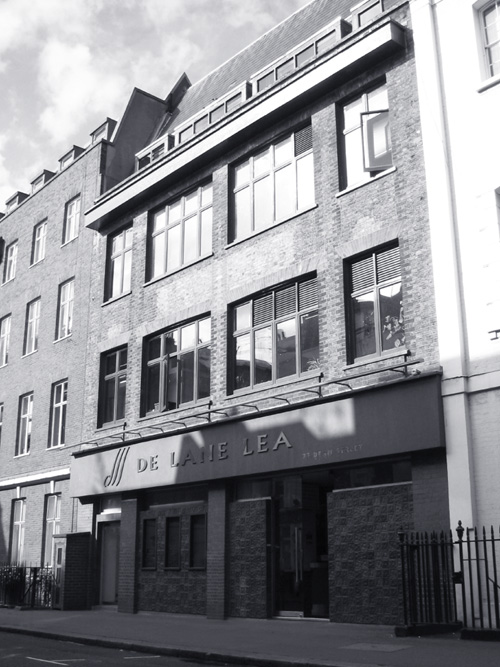
De Lane Lea, where the sound for Cold Mountain was mixed in London.
Saturday, June 14, 2003, Murch’s Journal
Get up at 7:30 and be at work before nine.
With that entry, on the first day of sound mixing at De Lane Lea studios in Soho, Murch goes off-journal for the next week and a half. Like the Apollo I circling behind the moon, he’ll be out of radio contact before beginning the trip home to Earth. “It was a scattered time,” Murch recalls later, “with Aggie’s mother dying and lots of cross-Atlantic flying and cutting and mixing, etc.”
There are several top-notch facilities for sound mixing in and around London. Miramax, in consultation with Murch and Minghella, had selected the re-recording theater at De Lane Lea in London’s West End. They chose it over either the Pinewood or Shepperton studios, both of which are on the outskirts of London, due in part to its location, being reasonably close to Murch and Minghella’s base of operations at the Old Chapel—about 20 minutes by taxi or tube, or a 45 minute walk from Murch’s house in Primrose Hill. Mixing there, within the vibrant narrow streets of Soho, also means every kind of motion picture and media post-production service or supplier is in walking distance. The Cold Mountain sound editors are set up nearby at Goldcrest, a long-standing sound studio; Double Negative, which is doing visual effects, is two blocks away; and the film lab, FrameStore/CFC, is also close by.
De Lane Lea contains three floors with editing rooms, a screening theater, a large music recording studio, offices, a café, and, on the first floor, a sound-mixing theater, (or mix stage), where Murch, Minghella, and the sound crew will spend much of the next six months preparing the soundtrack.
Among films using DLL-Soho for ADR and other sound services over the last few years are Pirates of the Caribbean, Master and Commander, Spider-Man, The Hours, and Gangs of New York. The second Harry Potter movie was mixed there after Cold Mountain.
A movie soundtrack blends three kinds of sound: dialogue, music, and effects. For filmmakers, this process of mixing sound is their final chance to shape a film. What filmgoers hear inside the theater is every bit as complex and emotionally important to storytelling as the images they watch—maybe more so, because sound should do its job at a subconscious level.
Every sound mix has its own personality and should properly complement the story being told. A soundtrack for a romantic comedy like Down with Love should be “bright”—it features contemporary pop songs, and brings intimate dialogue to the forefront. A thriller like Fight Club should sound “dark,” contain lots of jarring, spooky sound effects, and use a brooding musical bed. The soundtrack’s character is defined early on with discussions among the director, composer, location sound recordist, sound supervisor, sound designer (if separate from the supervisor), and sound editors. Before the picture is even finished being filmed, sound effects are found or recorded—on location, from existing effects collections, off location, and in the recording studio. In Cold Mountain, for example, sound supervisor Eddy Joseph and sound effects editor Martin Cantwell, spent two days recording gun collectors firing authentic Civil War munitions in the countryside north of London, an event specially arranged for this purpose.
Even at the script stage (and certainly by the time the first assembly is completed), the director and sound supervisor will “spot” the film, deciding which spots in the film should have which kinds of effects. Likewise, the director and the composer of the musical score together plan what sorts of music belong in which scenes. Even though the best quality recording of the actors’ words is taken on location, that “production sound” is often replaced later in the studio with ADR—because the quality on set was compromised by unwanted ambient sounds, technical problems, or faulty line readings. With Minghella, even more than with most film directors, ADR is an opportunity to rewrite the film one more time—replacing lines, rewriting phrases, adding voiceover—all for the purpose of sharpening story, character, and emotion. ADR is also used to obtain background conversation and off-camera dialogue color using “loop groups,” actors who, in a battle scene for example, articulate sounds such as grunts, cries, yells, and occasionally actual words, none of which were recorded during location filming.
There are four components to the mix: 1) the sound itself, created on a digital audio workstation (DAW) such as Pro Tools, and played directly from the workstation or off hard drives; 2) a mixing board, the electronic switching station with sliders, faders, equalization controls, and other functions (often automated) that is operated by the re-recording mixer; 3) the room itself, a small theater with real theater seats to approximate the acoustics of a theatrical environment; and 4) the sound mixer’s ears. While there are all sorts of devices to measure and graph sound, there are no objective criteria for what makes a good mix. What ultimately matters is how something sounds to the mixer, the director, and the producers. Like much of filmmaking, this process is an art supported by science.
Since it’s nearly impossible to physically manipulate all strands of dialogue, effects, and music at the same time (and mentally overwhelming to even hear them unmixed all together), movie sound is first prepared in “premixes.” That is, the sound effects are grouped together in different categories: atmospheres, munitions, footsteps, props, horses, etc., separated out for maximum flexibility in the final mix. Each group is premixed onto a six-track master, with each track sent to three speakers arrayed behind the screen, two in the walls and one in the rear (surrounds); then all the dialogue is premixed; and, finally, the music is laid in once the effects and dialogue are set. When the time comes to do the final soundtrack, the mixer works with these prepared ingredients, though the “raw” original tracks can easily be accessed if necessary from a workstation dedicated to this purpose.
The sound arrives at the premix in “split tracks.” Not only are music, dialogue, and effects separated from each other, each type of sound effect is segregated from other sound effects—again, for maximum flexibility. For example, 64 raw gunshot tracks in Cold Mountain’s battle scene have been reduced to one six-track premix, while sounds of horses’ hooves are on a different premix. That way the mixer can adjust the volume relationship between just those two sounds to best represent what’s on the screen—horses are made quieter because they’re in the background, guns are made louder since they are in the foreground. At the sound mix of Cold Mountain Murch, the lead sound mixer works with two other sound mixers, Michael Prestwood-Smith and Matthew Gough. When Murch is gone from the mix to edit, attend to other duties, or at preview screenings, Prestwood-Smith will do premixes, which must continue unabated if the film is to be delivered on schedule. On the mix board, Matthew Gough supplements Prestwood-Smith and Murch by handling controls that are too spread out and numerous for one mixer to manage.
For each reel, the mixers will ultimately bring together 128 tracks of sound effects, 32 tracks of music, and 24 tracks of dialogue at the appropriate volume levels in relation to each other and to the picture. But there is more to it than just how loud, or how soft: the texture must be in the proper equalization of bass and treble (EQ); the right amount and quality of reverberation must be added to match the visuals; the sound needs to be “placed” in a three-dimensional environment to make the best use of surround speakers; and—especially important to Murch—the audio transitions between scenes must match the story appropriately, and propel it emotionally.
The sound crew in Studio A at De Lane Lea. From left to right: Allan Jenkins, Simon Chase, Martin Cantwell, Tim Bricknell, Fer Bos, Anthony Minghella, Mark Levinson, Walter Murch, Michael Prestwood-Smith, Matthew Gough, and Eddy Joseph. Not pictured: Colin Ritchie.
For Murch, to both edit a movie and mix its soundtrack is second nature. He’s held both these credits on 11 previous motion pictures, beginning with The Conversation in 1974. For The English Patient he took home two Oscars, one in each of those categories, the first person in film history to do so.
Each of these jobs is a huge responsibility, a full-time commitment and a thorough-going artistic challenge. Doing them both may seem to overreach, a kind of grandiose ambition. While it requires a high degree of self-confidence, discipline, and physical stamina—all three of which Walter Murch has in full—it’s more a measure of his personality and disposition to handle picture and sound than any overblown sense of ego. Murch embodies a creative synthesis that often goes missing in filmmaking. These two seemingly disparate threads—image and sound—become more tightly bound up with each other when they emanate together from the start of the process. Says Robert Grahamjones, Murch’s former assistant: “Walter begins planning for the sound mix from the first day of editing.” The resulting film has a better chance of achieving a unity of purpose and affect because those elements are integrated from the beginning. Centrifugal forces that send many films flying apart are kept in check when someone with a strong vision occupies the center of gravity, be it the producer, director, or editor/mixer.
June 13, 2003, Murch’s Journal
Find the five or six places in the film that have the best quality dialogue recording and run them in the theater to tune your ears before you start premixing at DLL.
If, on this mid-June day, you open the heavy soundproof door into Studio A, the main De Lane Lea mixing theater, you see what looks like a movie playing up on the screen. The theater lights are turned down. The mix board’s controls and fader lights seem to brighten in the dark—all twinkly green and orange—sharp, like runway lights. What you hear is something quite peculiar: long periods of silence (the perfect silence of what audio engineers call a “dead room”) interrupted by Nicole Kidman and Renée Zellweger speaking, followed by more soundlessness until the characters speak again. This is a dialogue premix. For the moment Murch and the rest of the sound crew are working mixing on-camera dialogue tracks. They will continue, dialogue only, all the way through nine separate reels that constitute this three hour and four minute version of the film. When they are happy—or run out of time—they will begin premixing the sound effects.
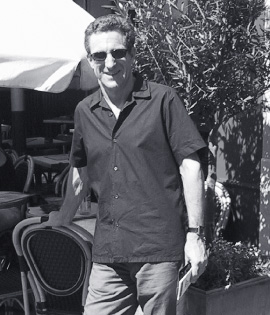
Mark Levinson, ADR supervisor.
Beside Murch and Prestwood-Smith, at the far left-hand side of the mixing board, dialogue editor Colin Ritchie sits at a Pro Tools sound editing workstation ready to make adjustments to the dialogue tracks as problems arise. He might need to remove a click or a pop, for example, that hadn’t been audible until they entered this theatrical environment. Or he might need to cut in an alternate line reading should Minghella decide he wants to convey a slightly different meaning. Behind Murch, sitting one tier up on a blue couch, is Mark Levinson, the ADR supervisor, who leans forward paying close attention. Levinson, who favors pastel, Polo brand dress shirts and drives a vintage burgundy Triumph convertible back in Berkeley where he lives, has been in London since April, working with Minghella to record, select, and edit into place newly recorded dialogue. Levinson works closely with Minghella, even helping to conceptualize and draft new lines for the actors to read.
Today, some of the material Levinson just recorded with Nicole Kidman, Jude Law, Brendan Gleeson, Ray Winstone, Natalie Portman, and Eileen Atkins is being mixed into the soundtrack for the first time. These were the first ADR sessions among the principals. But the process of adding and replacing dialogue will continue for the next six months, right up to the last minute, literally, when they mix in Nicole Kidman’s final ADR lines, turn off the mixing board, shut the lights, and close the door to Studio A.
ADR, or “looping” as it’s also called, takes place in a special sound-recording studio that contains video projection and sound recording capabilities. If it’s dialogue that must be matched exactly—lip-synced—a video copy with scenes from the movie gets prepared ahead of time. The scene is played over and over without stopping while the actor stands before a microphone watching it play on the screen. (In the days before video, they made a film loop of the scene so it could easily be projected over and over for the actors, hence the term “looping.”) Cueing tones, which the ADR editor added to the video (“streamer track”), precede the specific sections needing new dialogue so the actor gets a running start before speaking his or her lines. Some actors are very good at ADR and have little difficulty finding their character and manner of speaking again many months after filming is finished, even when immersed in a role for another movie.
An ADR supervisor working with Minghella is by definition deeply involved with shaping the final version of the movie. Given his collegial approach to filmmaking, that means Levinson is in close touch with Minghella’s inner workings and deepest thoughts about how to improve the film as it moves toward completion. Minghella used Levinson as his ADR supervisor on The English Patient and The Talented Mr. Ripley, and puts maximum trust in him. That’s good, since ADR also means working face-to-face with famous, often demanding, actors in re-recording sessions. By the time post production rolls around, actors are often on to their next films, squeezing ADR sessions into their off days or off hours. So a director and his ADR supervisor frequently travel far and wide just to get a few precious hours in the recording studio with an actor. Nowadays, ADR sessions are sometimes handled long distance via a high-speed ISDN link and video conferencing. Levinson might direct actors doing background voices—“loop groups”—in ADR sessions if Minghella can’t attend because of other pressing responsibilites. Levinson needs to fully understand what Minghella wants to accomplish in terms of story, character, and performance, while also being artistically astute and technically adept at editing that material into a pre-existing soundtrack. And like the rest of the sound editing team, an ADR supervisor needs to have a good ear.
For example, during production, while still in Northern California, Levinson wrote Murch an email about the Cold Mountain screenplay: “One of the things that astonished me with the script was Ant’s ability to totally absorb the Southern feel of dialogue (particularly Ruby’s character, where Ant has given her literacy but retained the spirit of the character from the book).” Then, remembering that Murch is using Apple’s Final Cut Pro software, which may have implications for the entire sound department, Levinson adds, “Is Final Cut Pro living up to its title, or proving to be a misnomer?”
It may seem that using Final Cut for picture editing should have little bearing on what Levinson does with ADR, since he works on the Pro Tools sound-editing platform (owned by Digidesign, which is part of Avid). However, Final Cut’s imprint on Cold Mountain post production is felt in all the departments, including Levinson’s. In fact, before arriving in London, Levinson anticipates advantages Final Cut might have for the tasks that lie ahead—such as quick trips to record ADR in Los Angeles, New York, Toronto, and elsewhere.
“Are you working with OS X?” Levinson wrote to Murch back in March. “Wondering if I should explore one of the new PowerBooks to construct a sort of portable system that I could bring with me to be able to spot with Ant at the ‘Chapel’ or his house or hotel rooms. Have you pushed the limits of your PowerBook?”
By building a portable system, that is, an Apple PowerBook with Pro Tools and Final Cut Pro installed, Levinson could be free to prepare for ADR sessions en route—and to incorporate last-minute script rewrites Minghella hands to him, or sends by email. After a recording session, Levinson can listen immediately to new takes, pick selects, and place them in his working version of the film. After a seven-hour plane ride back to London from New York, he will walk into a mix session at De Lane Lea with newly recorded dialogue from Nicole Kidman (the best takes already chosen and edited) and in a few moments transfer them into the Pro Tools workstation on the mix stage, which Murch accesses from the mixing board and mixes into the Cold Mountain soundtrack.
Minghella also benefits from having Final Cut Pro on his PowerBook when he is planning for ADR sessions. “I’ve been able to travel with the movie,” he says later. “When we were doing ADR in New York and Los Angeles, I could have the cut of the film on my laptop. I could examine the film with fluency and ease, as opposed to when you have to use a videotape machine.”
JUNE 14, 2003—LONDON
It’s the second day of mixing at De Lane Lea. Murch is preparing the soundtrack for the private screenings of Cold Mountain, which are only six days away, first in London, then in New York for Miramax. Murch now knows the MetaFlow-Titan-OMF sound conversion workaround devised by Sean Cullen and the sound editors is performing. Sync is holding with the movie image Murch mixes to at DLL (a digital projection from videotape output from Final Cut Pro). There will be no meltdown. This is a moment to behold. From a couch at the back of Studio A, with his PowerBook hooked up to the house high-speed line, Murch dashes off an excited email to Will Stein, Bill Hudson, Brian Meaney, and Susan Marshall (FCP product marketing) at Apple:
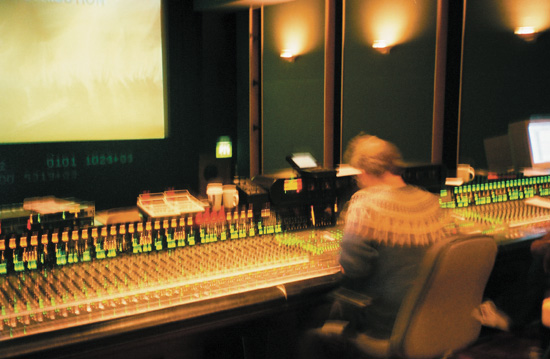
Murch mixing Cold Mountain.
Date: Monday, June 16, 2003, 12:43 PM
Subject: Mixing Cold Mountain!
From: Walter Murch
Dear Apple FCP:
We are two days into our six-day temp mix, and all is going splendidly. We have finished the dialogue premixes for the whole three-hour film, and all of the EDL-Titan interface between FCP and PT worked out perfectly.
Naturally, I am interested in any advantages we can gain by using the emerging AAF - XML pathways, but I wanted to let you know that our workarounds are all functioning well.
We are also in the middle of implementing changes to the conformed 35mm picture, and that is also flowing smoothly and frame-accurately.
Best wishes,
Walter M.
Getting permission from Apple for DigitalFilm Tree and Brooks Harris to customize the unfinished XML protocol is now moot. The mix will proceed without any hidden technical issues arising. There is no response from Apple.
Ramy, back in Los Angeles, receives a similar email from Murch with the good news. He responds to Murch right away:
Date: Tue, 17 Jun 2003 22:26
Subject: Re: Mixing!
From: Ramy Katrib
To: Walter Murch
Good Day Walter,
Thank you for the update. We are extremely happy and comforted about the workarounds working. As we have learned, FCP’s professional trajectory has been built on a bedrock of workarounds. We will continue to hunt down AAF/OMF - XML pathways with the hope that Apple’s resistance to that will lessen, or go away. I’ve confirmed a free pass for Brooks from one of our Apple contacts. I just spoke with him, and if all goes as planned, he’ll attend the developers conference next week, on all our behalf.
all the best, ramy
While no outright conflict ever erupted between Apple, DFT, and Murch over XML, there was an undertone of tension and frustration running through their communications. Murch, Cullen, and DFT knew a better solution for their sound workflow was very close at hand. Apple is in the business of selling reliable computers and software applications that keep customers happy. The company could not put resources into providing a “special build,” as they call customized software, for a single customer, no matter how prominent and potentially useful Cold Mountain might be as a showcase project.
Zed Saeed at DigitalFilm Tree remains philosophical about the XML tug-of-war: “Give them credit,” he says about Apple. “You know why? Look at their applications. DigitalFilm Tree is a direct descendent of that spirit. A lot of people say Apple creates an image by writing huge paychecks to ad agencies and for image campaigns,” Zed continues. “Yes, I’ll live with that. It allows me to use my brain, my talent, my outlook, to work on movies, help cut films, and work right next to one of my heroes.”
JUNE 20, 2003—LONDON
Today is the first full screening of Cold Mountain to be held outside either the Chapel or De Lane Lea. It’s an invited audience of 60: friends and associates of Minghella’s, other filmmakers, writers, and the London Mirage company staff. It will be held at the National Film Theatre. The NFT, part of the British Film Institute, is in the South Bank complex on the Thames River. For Minghella, having recently been appointed to the prestigious position of chairman of the BFI, showing a film here is like playing football on the home pitch—a good way to test the film before taking it across the Atlantic to show Miramax. One might think a hometown crowd would be the best way to make a transition onto the main stage. However, these sorts of audiences can prove to be the most troublesome for filmmakers, especially at this point. Friends and family rarely tell you the truth about how they feel. They care more about you and your feelings than they do about the work you produce. There’s a niggling sense that despite the praise, you may not hear what the audience truly believes.
Afterwards, Murch first checks in with Ramy at DigitalFilm Tree.
Date: Sat, 21 Jun 2003
Subject: Re: Screening
From: Walter Murch
To: Ramy Katrib
Dear Ramy:
Our screening at the NFT with the mixed track went without a hitch.
Looked good and sounded good. Sean loaded the cut from FCP directly into the QuBit, and then we ran the mix from our Akai dubber. Everyone very happy.
And the latest round of changes have been done to the 35mm film, so the change lists worked perfectly.
So the final two hurdles—change lists and 24bit sound export to Pro Tools—have gone along smoothly. Now all we have to do is concentrate on making the film!
Congratulations to all of us, and thanks for your invaluable help.
Best wishes and have a great time in Hawaii!
Walter
PS. Here is a link for a picture of the real Cold Mountain in NC
Date: Sat, 21 Jun 2003
Subject: Re: Screening
From: Ramy Katrib
To: Walter Murch
Hello Walter,
I was just about to leave the office for the final time before boarding a plane to Maui on Sunday. This is by far the best news of the year for us. I will pass along the wonderful developments to all. I never realized that mountain we’ve all been climbing was so beautiful.
sunny regards,
ramy
Then Murch gets right back to work by making some trims based on what he just saw on the screen. In an email to Debbie Ross, who will be designing the main title and end credit sequences at her studio in Los Angeles, Murch reports: “Our screening went very well—good digital projection and sound, and good response. We are still learning things, of course, and I just made changes to three reels, which shortened things by a minute.”

View of Cold Mountain in North Carolina.
June 25, 2003, Murch’s Journal
Having a coffee at Primrose Hill Patisserie before I go to the airport to fly to NY for the Miramax screening. God bless this endeavor and may some good come out of it. I was cleaning out the house and discovered that half of the plants on the terrace have died because I didn’t water them. Embarrassing oversight. How best to fix?
In New York at the SoHo Grand at 5.30. I met Albert and Ron in the lobby. Sean is on the way to the screening room—they had experienced some “tearing” in the image when they loaded it, so they did two loads (normal and progressive).
JUNE 25, 2003—NEW YORK CITY
Within an hour of arriving and checking into his hotel, Murch walks a few blocks to the brick building at 475 Greenwich Street, home to Miramax Films, Robert De Niro’s Tribeca Productions, and the Tribeca Film Center. There on the fourth floor, in the screening room, a run-through of Cold Mountain is about to begin. Minghella, Murch, some of the crew (costume designer Ann Roth, script supervisor Dianne Dreyer), and two of the producers, Albert Berger and Ron Yerxa, are there. Sean Cullen arrived one day earlier from London so he’d have enough time to transfer the current version of the film from Beta SP videotapes (made with output from Final Cut Pro in London) to a QuBit hard drive digital playback system—a process that takes nearly four hours, since it is done in real time.
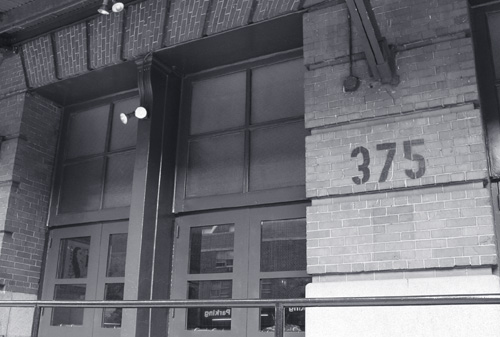
The front entrance to Miramax Films and the Tribeca Film Center in New York City.
The video projector is an overhead box with a loud fan, and being neither bright enough nor far enough back from the screen (a distance known as the “throw-length”), the image is small. Murch is also unhappy with the sound system. It isn’t as good as the NFT theater in London, and lacks high-end frequency response. There is no time to tune the room per Murch’s modus operandi—an irritant since Murch knows how good the soundtrack really sounds. But such is the fate of the sound mixer. Compared to how it sounded inside Studio A at De Lane Lea, Cold Mountain will sound slightly different in every theater it is shown.
But the screening goes well. Afterward Ann Roth turns to Anthony and says, “You’re not old, but this may be your masterpiece.” Murch says, referring to the script supervisor, “Dianne liked it but was immediately thinking of things to cut out.”
JUNE 26, 2003—NEW YORK CITY
June 26, 2003, Murch’s Journal
People are assembling at 1:30 for second screening at MMX. About 40 people. We tuned the room and it now sounds much better. Bless this screening and all who sail upon her. Executives and Sydney P. are here, and like the changes we made and the work we did on the sound.
June 27, 2003, Murch’s Journal
Screening for MMX yesterday went well. Much enthusiasm tempered by an awareness of what the length is, and the desire to have the relationship between Ada and Inman be as intense as it can be. Technically, all went well. They felt the image looked very good—better than the resolution they are used to in Avid output screenings. A meeting in conference room afterwards. Harvey and then Bob. Bob felt there was more heat between Sara and Inman than between Inman and Ada. “But when they get together it is great.”
MMX have agreed to shoot a couple of extra days—“no budget restraints, but let’s preview the film on July 15th and see if there’s anything else we need.”
Anthony said it was always amazing to him how much of a hot problematical potato I was for HW and other MMXers.
I am still just blinking in the sunlight of having completed the MMX showing with all its bells and whistles and complications.
Now having a mojito at a Latin bar up the street from the hotel.
Is there a way to play the mix on FCP in my room, through Dolby decoders with boom? Where can we get a CP50 Dolby decoder?
I am overwhelmed at the logistical and statistical difficulty of people getting together with an “intended”—someone who is destined for them, to enhance and complete them and vice-versa. Just looking at people walking around the streets of NY. Everyone seems so vulnerable and guarded to protect their vulnerability. How did Aggie and I get so lucky? One hour left before the car comes to pick me up.
Congratulations to Sean for guiding the film through all of its wiggling in the last six weeks. There is a screening for Charles Frazier on Sunday. Time to start thinking about going to the airport. God bless the forces that have gotten us to this place.
I am sitting on Broome Street with a solid traffic jam in front of me—four lanes. Broome and Wooster. Lovely sandblasted Mission-style brick six-story opposite. People listening to the most mindless insect music on their car radios. Now the man just turned to the theme from “The Godfather.”
Minghella stays on in New York while Murch returns to London to continue editing. At a screening room on Broadway Minghella shows this version of Cold Mountain to author Charles Frazier, Disney Chairman Michael Eisner (Disney owns Miramax), and others. Entertainment industry protocol behooves directors to share their incomplete work with financiers, key people, and influential opinion-makers, even if the movie is a long way from being finished. Like a Renaissance artist preparing frescoes for a Florentine chapel, when Lorenzo de Medici and the Pope want to come take a look, it’s not too wise to say no.
With these screenings the concomitant set of notes—written and spoken—come, too. And for a film director whose radar gets especially sensitive from working with actors, nonverbal notes sent through body language and speaking tone can mean just as much as any memo. Now is the time when filmmakers must find space to store all this new information. Albert Berger emails a four-page memo, Charles Frazier writes two pages of notes, Michael Peretzian, Minghella’s agent at Creative Artists, sends a page and a half. It’s not a matter of whether the response is simply good or bad; in most cases the reaction is very positive. Simply opening up to other views and opinions takes a little getting used to after working in relatively cloistered quarters for six months. Even if a comment touches on an issue you, as director or editor, have been worried about—perhaps already struggling to address—it’s disconcerting to hear about it from someone else. But in one respect, this gestation period of preliminary screenings and showings is a chance once again for Murch and Minghella to adjust to the fact that a motion picture is valuable only insofar as an audience will be there to experience it.
Date: Mon, 30 Jun 2003 08:30 EDT
Subject: cave be gone
To: Walter Murch
From: Anthony Minghella
Frazier screening went very well.
Escaping here without too much blood on our noses. Back to work.
Thanks for everything you do for me, dear friend
Rushing to adr
Love
A
Now, on regrouping in London, another milestone appears right up ahead: a public test preview screening in three weeks on July 21 in New Jersey. For Murch this means just about every post-production function required for finishing Cold Mountain is underway—all at once. On top of trying new editorial changes and making efforts to reduce the running time, Murch is involved in, supervising, or contributing to tasks that include special visual effects, title and credit sequences, dialogue and sound effects premixes, music recording, ADR, and even marketing (supplying material for a preview trailer to be cut in New York). It’s like that Vaudeville act of keeping a dozen plates spinning simultaneously on pointed wooden sticks: forget to keep one rotating fast enough and it soon comes crashing to the floor.
With Murch at the hub for all this completion activity, so too is Final Cut Pro at the crux. All new and revised material, from music to digitally touched-up shots must be incorporated into his assembly, which sits in FCP on the hard drives in the attic at the Old Chapel. All the elements arrive here in the form of QuickTime files, Apple’s powerful, cross-platform format for manipulating, enhancing, and storing image and sound. QuickTime is the universal language through which the Cold Mountain post-production departments talk to each other.
For example, there are many film shots that need digital touch-ups—wires removed, twinkling stars added, zoom-ins performed. These visual effects shots, done at Double Negative, a Soho-based effects-design company—can run from a few seconds to a minute or more. They are created with software applications Alias’ Maya, Apple’s Shake, and Pixar’s Renderman, then saved as QuickTime files. Dennis Lowe, the visual effects artist, or his assistant, Fay McConkey, notifies Sean Cullen and Dei Reynolds via email when the revised shots are available on the dedicated FTP site. Then Cullen transfers that shot onto the Cold Mountain shared area network (SAN). He notifies Murch by email that a new shot is ready for him to review.
It may seem over the top that Cullen would email Murch, who is just 30 feet away down the hall, but this way of communicating allows Murch to attend to visual affects when he can, rather than be interrupted in the middle of cutting a scene. Murch views the new shot, compares it to the original, and decides whether it’s correct or needs more work. (In most cases, it’s the latter. Like most other functions in post production, digital visual effects never come out right the first time.) The portability of this visual effects shot, and its immediate viewability, is only possible because of QuickTime. Double Negative, in fact, runs on PC computers, but that’s immaterial, because Mac and PC platforms read QuickTime.
Compare this pathway to traditional film-based, optically created effects. Aside from the fact that computer-generated images (CGI) are faster to create, more accurate, and better refined, a digital delivery system saves time and money. Formerly, a touched-up image would have to be printed on film at the lab (24 hours to process the negative and make a workprint copy), then shipped or sent by messenger to the editing room for screening on an editing machine. Or, if it’s more convenient (and can be scheduled soon enough), the film is shown at the lab in its viewing room, which might not happen until the editor is at the lab for some other reason.
Murch describes how it was done on his film, Return to Oz, only 20 years ago: “We were doing claymation visual effects in Portland, Oregon. We’d get a piece of film in London by special delivery. They would have another print made from the same negative so we could see the same things. I would put the film on my Steenbeck in London, and they’d put their film on their Steenbeck in Portland, and then I’d phone them up and we’d start with the footage counter at zero. I would go forward until I saw something that needed a comment, ‘Okay, everything’s great, but look at frame 74. Do you see how he winks there? Let’s make that a little more noticeable.’ And they’d be looking at the same thing. Or, if I had an idea for how to do something different, I would put a piece of tissue paper on the screen and draw the new idea on it and fax that to them, and then they’d get it instantly and put it over their screen and do a change and send it back. Even back then, I began to get a whiff of this digital thing, even though that was before email or downloadable files. But there was fax, and digital information was in that fax signal, going back and forth, which did energize the process.”
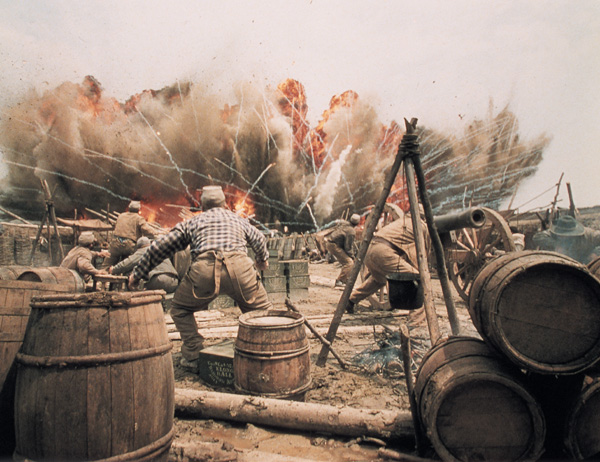
Visual effects were used to enhance details in the explosion that started the Battle of Petersburg.
Of course, viewing visual effects in Internet time, for example, gets integrated into a compressed post-production schedule. “We don’t get two extra days to do something else,” as Murch says.
Date: Thu, 10 Jul 2003 10:35
Subject: Fwd: jpegs on FTP site
From: Sean
To: Walter
Walter,
These shots are in your VFX project under Shots for Review, 10/7.
Begin forwarded message:
> From: Fay McConkey
> Date: Wed Jul 9, 2003 7:24:09 PM Europe/London
> To: Dei, Sean Cullen
> Subject: jpegs on FTP site
>
> Hello
>
> I have put 2 x jpegs on to your ftp site.
>
> Please could you show them to Anthony and Walter to get some feedback.
>
> 4013
> This temp frame is to decide the size and position of the cloud in the
> background of the shot; at the moment it is 50% the size of 4014.
>
> 4014
> This is the wide shot of the mushroom cloud that needs to be
> ‘zoomed’. In this test frame the cloud has been scaled to 78% - the
> smallest it can be if it is still to fit the 1.66 mask. We have just
> copied and pasted in the sides of the field for now.
>
> If you could let me know what they think, it would be much appreciated.
>
> Thanks
> Fay
An email from Double Negative, the London firm that provided Cold Mountain with its special visual effects. Minghella and Murch are being asked to review two visual effects shots, labeled 4013 and 4014, for the great explosion in the Battle of Petersburg.
Ultimately there will be 243 visual effects shots in Cold Mountain. Ordering, reviewing, directing, re-reviewing, and incorporating all that material through multiple rounds of approvals takes up a major chunk of time every day. To keep track of all the visual effects shots and their status, the Cold Mountain assistants line the hall upstairs at the Chapel with printed frame grabs, each frame coded to indicate its stage in the process.
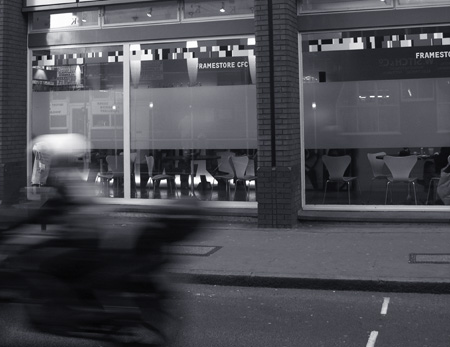
Computer Film Company lab (CFC) around the corner from De Lane Lea in Soho.
JULY 5, 2003—LONDON
Murch and Minghella do their first test of digital color correction on Cold Mountain at the Computer Film Company lab (CFC) around the corner from De Lane Lea in Soho. It’s exactly one year since DigitalFilm Tree spent the Independence Day holiday weekend prepping and packing Murch’s Final Cut Pro system for shipment to Romania.
That first DI color correction test was of the rainy porch scene at Black Cove Farm between Inman and Ada. “It turned out very well on first pass,” Murch says later. “We incorporated a film output of that test into the 35mm print used in the first preview screening to see how it held up alongside workprint from original negative. It integrated seamlessly.”
In a lengthy journal entry, Murch steps back and takes a wide view of the art and technique of film editing, amazed and curious about how it unfolds over time. Perhaps the notes are triggered by his first encounter with the digital intermediate technique, or maybe it’s that his 60th birthday is two days away.
July 10, 2003, Murch Journal
Film Editing—exciting that it is still in an early stage of its evolution. The underlying values of storytelling remain the same, but the techniques of image manipulation, storage, and documentation are transforming, along with the grammar of image sequence. But by how much? Juxtapose “Conversation” with “Cold Mountain” and what is different in the grammar? In some way, “Conversation” is more advanced. Jump cuts in the workshop and the Jack Tar Hotel sequences.
There is an optimal structure to the image sequence in any particular film. Just as there is an optimal molecular structure for every particular combination of atoms. “Least energy,” I think they call it. If the atoms are arranged in a different pattern, even by a small amount, the properties of the resulting molecular substance are different. A diamond and a graphite pencil are both made of the same carbon atoms, but in a different arrangement. The diamond pattern is optimal, most densely packed, “least energy,” which is what gives it its density and clarity. And given a particular structure, there is an optimal cut point for every shot (atom) within that structure.
It’s all well and good that the first public preview of Cold Mountain comes up in less than ten days, that this new version is not yet locked, and four days of temp mixing still lie ahead. Walter’s birthday trumps all that. He and Aggie spend a long weekend in Paris to celebrate. For Walter there are deep sleeps on the train ride from London and in a friend’s apartment where they are staying. Taking this kind of hiatus in the middle of the race to complete Cold Mountain can certainly be good for the mind and body, but suddenly slowing down from such a rapid pace can induce a certain kind of melancholia.
Walter Murch celebrates his 60th birthday at Veeraswami’s, a London restaurant where, 40 years earlier, he took Aggie on their first date. On his left are director Anthony Minghella and his wife, Carolyn Choa.
July 12, 2003, Murch’s Journal
60th birthday: Both my father and his father, both Walter Murches, died when they were sixty. May I break the tradition, Inshallah. Dad died on December 11th 1967, just under four months after his 60th birthday. For me that will be somewhere around November 6th. I remember getting the phone call from my mother—in the evening. Aggie and I were living in the little house on Cheremoya in LA, and Aggie was working night shift at Hollywood Presbyterian. I went for a walk along the streets in the hills just above the house. I remember thinking: “Well, he was old.” I was 24... what did I know. Two years later, my mother died.
Was I sad? Yes. Was I devastated? No. I had grown up with him but independent of him as far as my emotions were concerned. Still, I don’t know why I wasn’t more wrenched. I remember in New York that Xmas retreating into some mathematics.
SATURDAY, JULY 19, 2003—LONDON
Having spent the following week making final changes to version seven and completing the temp sound mix, Murch and Cullen prepare to fly to New York for a Monday night screening in New Jersey. Minghella had to leave a day earlier to do some ADR in New York. Less than two hours after finishing the mix, they walk to Mr. Young’s, Minghella’s favorite screening room in London. There, along with sound supervisor Eddy Joseph and music editor Allan Jenkins, they watch the film all the way through. Murch notes, “I feel a bit ‘out of body’ at the moment. Shaky.” The picture looks good and is perfectly in sync, except for two places where Murch had earlier “slipped sync” during the mix to make a last-minute sound adjustment and forgot to readjust. Nearly all the N-VIS-O splices are good, meaning the film does not stutter on the splices. Dei and Walter fix the few bad splices in the projection booth at Mr. Young’s. Another triumph: picture editing, sound mixing, ADR, sound editing, and 35mm picture conforming all intersect successfully—and Final Cut Pro is the hub of it all.
July 19, 2003, Murch’s Journal
Eddy and Alan were at the screening and proud of the work they had done. First time any of us have seen the 35mm picture projected with all the sound effects, ADR, etc. I was (mostly) dry-eyed except when I would get “work vertigo” from contemplating how high up we are on the mountain of work that has been done. Most unstuck at the campfire scene between Ada and Inman. Bless this film and all who work on it. Another Rubicon crossed.


